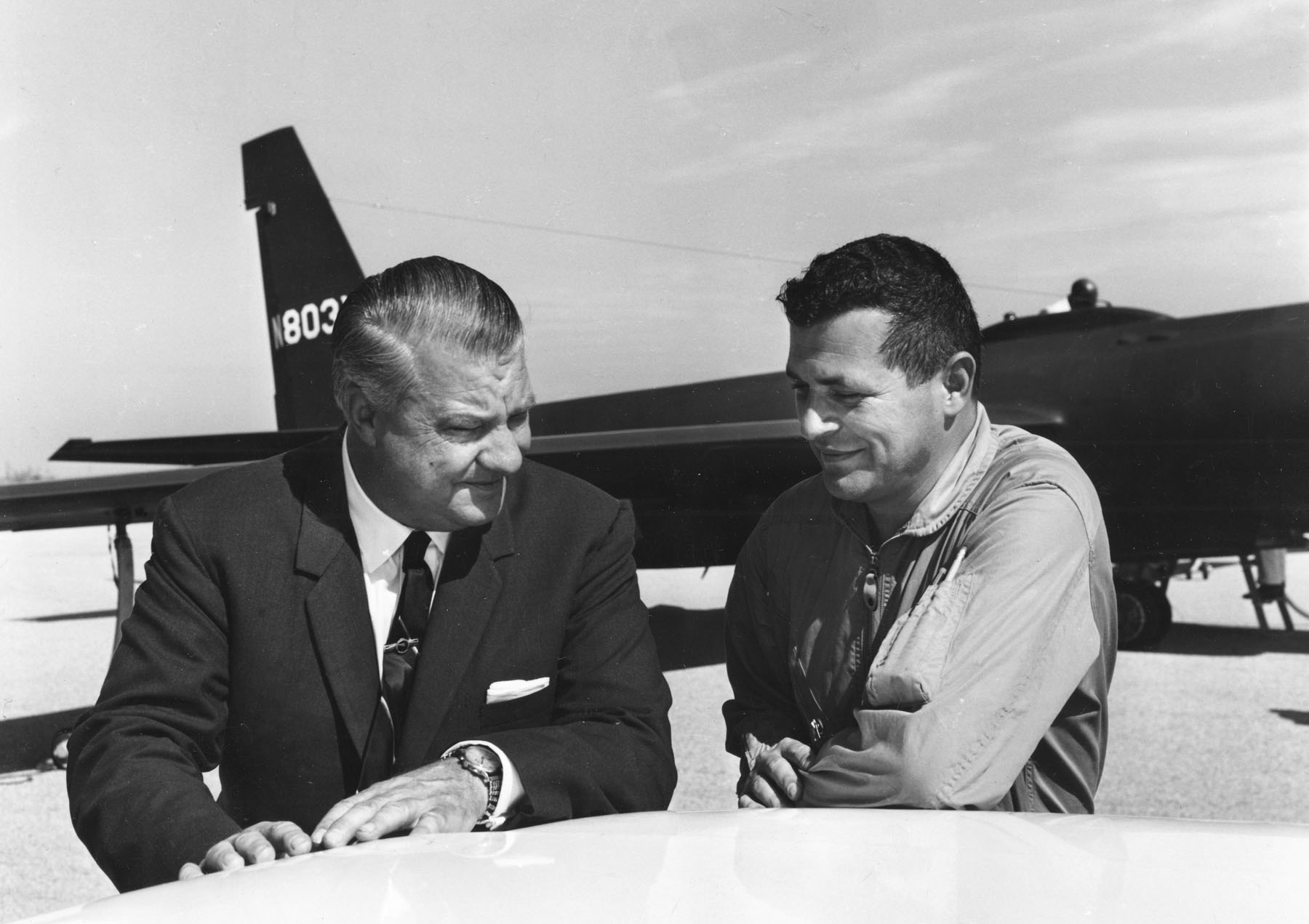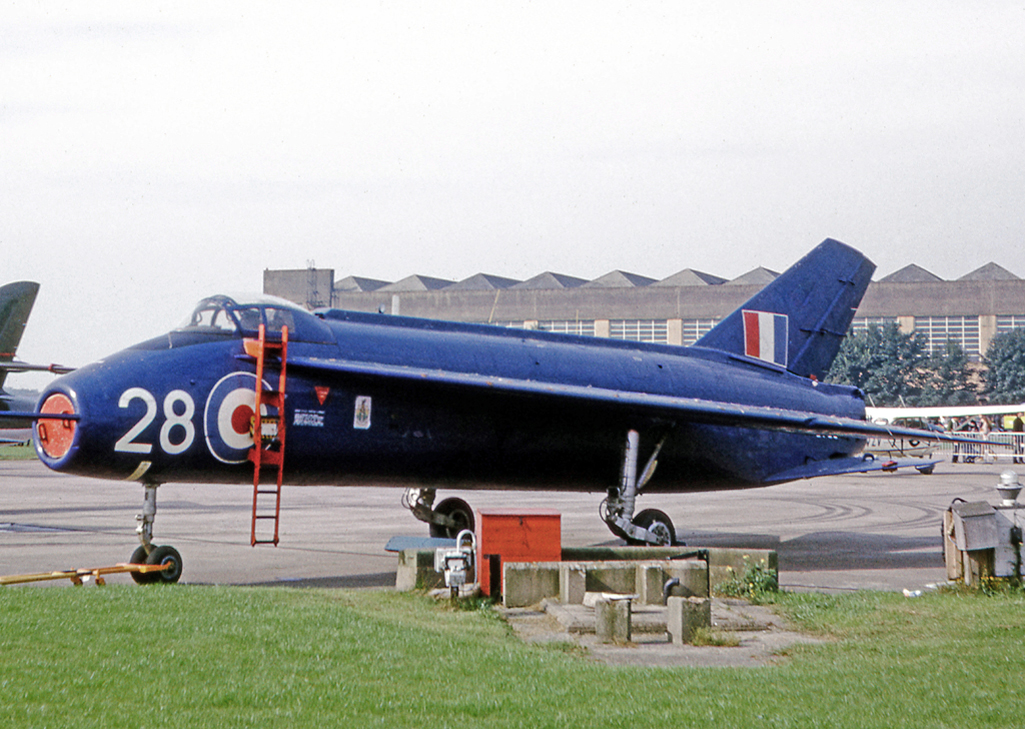|
Bristol Siddeley Orpheus
The Bristol Siddeley Orpheus was a single-spool turbojet developed by Bristol Siddeley for various light fighter/trainer applications such as the Folland Gnat and the Fiat G.91. Later, the Orpheus formed the core of the first Bristol Pegasus vectored thrust turbofan used in the Harrier family. Design and development The engine had its genesis in a 1952 request by Teddy Petter of Folland for an engine in the 5,000 pounds (22 kN) class to power a new trainer and lightweight fighter-bomber they were developing. Stanley Hooker, relatively new to the company after an earlier career at Rolls-Royce, took the project under his wing. He delivered a relatively simple and easy to maintain engine, which was put into use in the Folland Gnat, flying in 1955. The Orpheus incorporated the novel feature of a large-diameter shaft for its single spool which then needed only two bearings. The weight savings from deleting a bearing and associated parts listed below gave an engine with ... [...More Info...] [...Related Items...] OR: [Wikipedia] [Google] [Baidu] |
Flugausstellung Hermeskeil
The Flugausstellung Peter Junior, previously the Flugausstellung Hermeskeil, is a private aviation museum in the town of Hermeskeil in the German state of Rhineland-Palatinate. The museum opened in July 1973 in several buildings with a covered area of over 3,600 square meters. Today, it is home to over 100 civilian and military aircraft displayed on a 76,000 square meter site. Collection * Aérospatiale SE 3130 Alouette II ''M-234'' * Aérospatiale SE 3130 Alouette II ''V-248'' * Antonov An-2T ''16247310'' * Antonov An-26 ''52+08'' * Aero L-39 Albatross ''28+30'' * Bell UH-1D Iroquois ''72+31'' * Blériot XI * Boeing-Stearman PT-18 ''40-1964'' * Brantly B-2 ''93'' * Bristol Sycamore ''78+33'' * Canadair Sabre ''JC+101'' * CASA 2.111 ''BR.2I-14'' * CASA 352L ''T.2B-127'' * Concorde – replica * Convair F-102 Delta Dagger ''56-1125'' * Dassault Mirage IIIR ''310'' * Dassault Mirage V ''BA-35/54'' * Dassault Super Mystère B.2 * de Havilland Dove ''XJ348'' * de Havilland C ... [...More Info...] [...Related Items...] OR: [Wikipedia] [Google] [Baidu] |
Rolls-Royce Limited
Rolls-Royce was a British luxury car and later an aero-engine manufacturing business established in 1904 in Manchester by the partnership of Charles Rolls and Henry Royce. Building on Royce's good reputation established with his cranes, they quickly developed a reputation for superior engineering by manufacturing the "best car in the world". The business was incorporated as Rolls-Royce Limited in 1906, and a new factory in Derby was opened in 1908. The First World War brought the company into manufacturing aero-engines. Joint development of jet engines began in 1940, and they entered production. Rolls-Royce has built an enduring reputation for development and manufacture of engines for defence and civil aircraft. In the late 1960s, Rolls-Royce was adversely affected by the mismanaged development of its advanced RB211 jet engine and consequent cost over-runs, though it ultimately proved a great success. In 1971, the owners were obliged to liquidate their business. The useful p ... [...More Info...] [...Related Items...] OR: [Wikipedia] [Google] [Baidu] |
Kelly Johnson (engineer)
Clarence Leonard "Kelly" Johnson (February 27, 1910 – December 21, 1990) was an American aeronautical and systems engineer. He is recognized for his contributions to a series of important aircraft designs, most notably the Lockheed U-2 and SR-71 Blackbird. Besides the first production aircraft to exceed Mach 3, he also produced the first fighter capable of Mach 2, the United States' first operational jet fighter, as well as the first fighter to exceed 400 mph, and many other contributions to various aircraft. As a member and first team leader of the Lockheed Skunk Works, Johnson worked for more than four decades and is said to have been an "organizing genius". He played a leading role in the design of over forty aircraft, including several honored with the prestigious Collier Trophy, acquiring a reputation as one of the most talented and prolific aircraft design engineers in the history of aviation. In 2003, as part of its commemoration of the 100th anniversary of t ... [...More Info...] [...Related Items...] OR: [Wikipedia] [Google] [Baidu] |
Skunk Works
Skunk Works is an official pseudonym for Lockheed Martin's Advanced Development Programs (ADP), formerly called Lockheed Advanced Development Projects. It is responsible for a number of aircraft designs, beginning with the Lockheed P-38 Lightning, P-38 Lightning in 1939 and the Lockheed P-80 Shooting Star, P-80 Shooting Star in 1943. Skunk Works engineers subsequently developed the Lockheed U-2, U-2, Lockheed SR-71 Blackbird, SR-71 Blackbird, Lockheed F-117 Nighthawk, F-117 Nighthawk, Lockheed Martin F-22 Raptor, F-22 Raptor, and Lockheed Martin F-35 Lightning II, F-35 Lightning II, the latter being used in the air force, air forces of several countries. The Skunk Works name was taken from the "Skonk Oil" factory in the comic strip ''Li'l Abner''. The designation Skunkworks project, "skunk works" or "skunkworks" is widely used in business, engineering, and technical fields to describe a group within an organization given a high degree of autonomy and unhampered by bureaucracy, ... [...More Info...] [...Related Items...] OR: [Wikipedia] [Google] [Baidu] |
Lockheed JetStar
The Lockheed JetStar (company designations L-329 and L-1329; designated C-140 in US military service) is a business jet produced from the early 1960s to the 1970s. The JetStar was the first dedicated business jet to enter service, as well as the only such airplane built by Lockheed. It was also one of the largest aircraft in the class for many years, seating ten plus two crew. It is distinguishable from other small jets by its four engines, mounted on the rear of the fuselage, and the "slipper"-style fuel tanks fixed to the wings. Development The JetStar originated as a private project within Lockheed, with an eye to winning a United States Air Force (USAF) requirement that was later dropped due to budget cuts. Lockheed decided to continue the project on its own for the business market. The first two prototypes were equipped with two Bristol Siddeley Orpheus engines, the first of these flying on 4 September 1957. The second of these was also equipped with the wing-mounted ... [...More Info...] [...Related Items...] OR: [Wikipedia] [Google] [Baidu] |
Short SB5
The Short SB.5 ( serial ''WG768'') was a "highly unorthodox, adjustable wing"Staples K.J. British research aircraft designed by Short Brothers in response to the UK Air Ministry requirement ER.100; to provide input for the design of the English Electric P.1 (prototype of the English Electric Lightning) by testing the low speed flight characteristics of various configurations of wing-sweep required for supersonic flight. The tailplane could be mounted either on top of the fin ("T-tail") or below the fuselage. The tests ultimately confirmed that the original P.1/Lightning design was an effective configuration for high speed flight. Design and development A technical dispute arose between the Royal Aircraft Establishment and the English Electric Company (EEC) as to the optimum configuration for the company's proposed supersonic fighter. A single-seat, mid-winged research machine was built to investigate the low speed handling of the possible configurations. The same basic configur ... [...More Info...] [...Related Items...] OR: [Wikipedia] [Google] [Baidu] |
Hunting H
Hunting is the human practice of seeking, pursuing, capturing, or killing wildlife or feral animals. The most common reasons for humans to hunt are to harvest food (i.e. meat) and useful animal products (fur/ hide, bone/tusks, horn/antler, etc.), for recreation/taxidermy (see trophy hunting), to remove predators dangerous to humans or domestic animals (e.g. wolf hunting), to eliminate pests and nuisance animals that damage crops/livestock/poultry or spread diseases (see varminting), for trade/tourism (see safari), or for ecological conservation against overpopulation and invasive species. Recreationally hunted species are generally referred to as the ''game'', and are usually mammals and birds. A person participating in a hunt is a hunter or (less commonly) huntsman; a natural area used for hunting is called a game reserve; an experienced hunter who helps organize a hunt and/or manage the game reserve is known as a gamekeeper. Many non-human animals also hunt (see predat ... [...More Info...] [...Related Items...] OR: [Wikipedia] [Google] [Baidu] |
HA-300
The Helwan HA-300 ( ar, حلوان ٣٠٠) was a single-engine, delta-wing, light supersonic interceptor aircraft developed in Egypt during the 1960s. At various stages, Spain and India were involved in the development program. Spain was financing two projects, the HA-200 and the Hispano HA-300, but cancelled the HA-300 project before a prototype was built due to overruns. Egypt then took over financing, and the program was transferred to Egypt where both it and its engine would be made, and where the aircraft was successfully flown. Near the end of the program, India began financing the development of the E-300 engine for use in the Indian HF-24 Marut jet fighter. The HA-300 was an ambitious and costly project for Egypt, at a time when it was seeking to expand both its civilian and defence aviation industry. Design and development Hispano HA P-300 (HA-23P) At the end of World War II, German aircraft designer Willy Messerschmitt moved to Spain, where he joined Hispano Aviac ... [...More Info...] [...Related Items...] OR: [Wikipedia] [Google] [Baidu] |
Mutual Weapons Development Program
Mutual may refer to: *Mutual organization, where as customers derive a right to profits and votes *Mutual information, the intersection of multiple information sets *Mutual insurance, where policyholders have certain "ownership" rights in the organization *Mutual fund, a professionally managed form of collective investments *Mutual Film, early American motion picture conglomerate, the producers of some of Charlie Chaplin's greatest comedies *Mutual Base Ball Club (1857-1871), defunct early baseball team usually referred to as "Mutual" in the standings. *Mutual Broadcasting System, a defunct U.S. radio network * Mutual Improvement Association, the name of two youth programs run by the Church of Jesus Christ of Latter-day Saints *Mutual authentication, used in cryptography *"Mutual", a 2018 song by Shawn Mendes from ''Shawn Mendes'' ;Place names *Mutual, Maryland, a community in the United States *Mutual, Ohio, a village in the United States *Mutual, Oklahoma, a town in the United St ... [...More Info...] [...Related Items...] OR: [Wikipedia] [Google] [Baidu] |
NATO
The North Atlantic Treaty Organization (NATO, ; french: Organisation du traité de l'Atlantique nord, ), also called the North Atlantic Alliance, is an intergovernmental military alliance between 30 member states – 28 European and two North American. Established in the aftermath of World War II, the organization implemented the North Atlantic Treaty, signed in Washington, D.C., on 4 April 1949. NATO is a collective security system: its independent member states agree to defend each other against attacks by third parties. During the Cold War, NATO operated as a check on the perceived threat posed by the Soviet Union. The alliance remained in place after the dissolution of the Soviet Union and has been involved in military operations in the Balkans, the Middle East, South Asia, and Africa. The organization's motto is ''animus in consulendo liber'' (Latin for "a mind unfettered in deliberation"). NATO's main headquarters are located in Brussels, Belgium, while NATO ... [...More Info...] [...Related Items...] OR: [Wikipedia] [Google] [Baidu] |
Axial Compressor
An axial compressor is a gas compressor that can continuously pressurize gases. It is a rotating, airfoil-based compressor in which the gas or working fluid principally flows parallel to the axis of rotation, or axially. This differs from other rotating compressors such as centrifugal compressor, axi-centrifugal compressors and mixed-flow compressors where the fluid flow will include a "radial component" through the compressor. The energy level of the fluid increases as it flows through the compressor due to the action of the rotor blades which exert a torque on the fluid. The stationary blades slow the fluid, converting the circumferential component of flow into pressure. Compressors are typically driven by an electric motor or a steam or a gas turbine. Axial flow compressors produce a continuous flow of compressed gas, and have the benefits of high efficiency and large mass flow rate, particularly in relation to their size and cross-section. They do, however, require several ... [...More Info...] [...Related Items...] OR: [Wikipedia] [Google] [Baidu] |
Cannular Combustor
A combustor is a component or area of a gas turbine, ramjet, or scramjet engine where combustion takes place. It is also known as a burner, combustion chamber or flame holder. In a gas turbine engine, the ''combustor'' or combustion chamber is fed high-pressure air by the compression system. The combustor then heats this air at constant pressure as the fuel/air mix burns. As it burns the fuel/air mix heats and rapidly expands. The burned mix is exhausted from the combustor through the nozzle guide vanes to the turbine. In the case of a ramjet or scramjet engines, the exhaust is directly fed out through the nozzle. A combustor must contain and maintain stable combustion despite very high air flow rates. To do so combustors are carefully designed to first mix and ignite the air and fuel, and then mix in more air to complete the combustion process. Early gas turbine engines used a single chamber known as a can-type combustor. Today three main configurations exist: can, annular, and c ... [...More Info...] [...Related Items...] OR: [Wikipedia] [Google] [Baidu] |

.jpg)







.jpg)